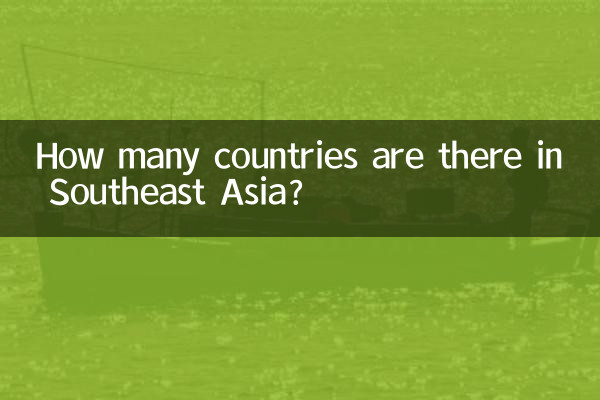How many countries are there in Southeast Asia: recent hot topics and structured data
As a dynamic region, Southeast Asia has attracted much attention in recent years in the fields of economy, culture, tourism and other fields. The following are topics related to Southeast Asia that have been hotly discussed on the Internet in the past 10 days, as well as structured data on the number of Southeast Asian countries.
1. Number and basic information of Southeast Asian countries

There are 11 countries in the Southeast Asia region. Here are their details:
| country | capital | official language | Population (approx.) |
|---|---|---|---|
| thailand | bangkok | Thai | 70 million |
| vietnam | Hanoi | Vietnamese | 98 million |
| malaysia | Kuala Lumpur | Malay | 33 million |
| singapore | singapore | English, Malay, Chinese, Tamil | 5.7 million |
| Indonesia | jakarta | Indonesian | 270 million |
| Philippines | manila | Filipino, English | 110 million |
| Myanmar | Nay Pyi Taw | Burmese | 54 million |
| cambodia | Phnom Penh | Khmer | 16 million |
| laos | Vientiane | Lao | 7 million |
| brunei | Bandar Seri Begawan | Malay | 440,000 |
| East Timor | Dili | Tetum, Portuguese | 1.3 million |
2. Hot topics in Southeast Asia in the past 10 days
1.Thailand’s visa-free policy triggers tourism boom: After the implementation of the mutual visa exemption policy between China and Thailand, Thailand’s travel search volume surged by 300%, with Bangkok and Phuket becoming the most popular destinations.
2.Vietnam's manufacturing industry accelerates development: With the adjustment of the global supply chain, Vietnam's foreign investment increased by 25% year-on-year, with the electronics and textile industries performing particularly well.
3.Singapore property market cools: The Singaporean government introduced a new round of real estate control measures, and the transaction volume of second-hand houses fell by 15% month-on-month.
4.Indonesian election draws attention: The Indonesian presidential election has entered the final sprint, and the policy propositions of the three candidates have become the focus of discussion.
5.Malaysia promotes digital economy: Malaysia announced that it will invest 5 billion ringgit to develop digital economic infrastructure, focusing on supporting the digital transformation of small and medium-sized enterprises.
3. A quick overview of Southeast Asia’s economic data
| indicator | 2023 data | year-on-year growth |
|---|---|---|
| Total regional GDP | $3.6 trillion | 4.7% |
| foreign direct investment | $220 billion | 12% |
| Cross-border e-commerce transaction volume | $80 billion | 35% |
| Number of international tourists | 120 million passengers | 150% |
4. Comparison of characteristics of Southeast Asian countries
Although the countries in Southeast Asia are geographically similar, they each have their own characteristics:
-thailand: Famous for tourism and rich in cultural heritage and natural landscapes.
-singapore: One of the global financial centers, known for its efficient government and clean environment.
-vietnam: A rising star in the manufacturing industry is becoming an important part of the global supply chain.
-Indonesia: The largest economy in Southeast Asia, rich in natural resources and significant demographic dividend.
-Philippines: The English language penetration rate is high, the service industry is developed, and it is an important BPO center.
5. Prospects for the future development of Southeast Asia
With the full implementation of RCEP and the acceleration of regional integration, economic ties among Southeast Asian countries will become closer. Digital economy, green energy, and high-end manufacturing will become key development areas in the next 10 years. At the same time, advantages such as a younger population structure and an expanding consumer market will enable Southeast Asia to continue to remain an important engine of global economic growth.
Overall, the 11 countries in Southeast Asia each have their own characteristics and together make up this vibrant region. Understanding the unique features of each country can help us better seize regional development opportunities.

check the details

check the details